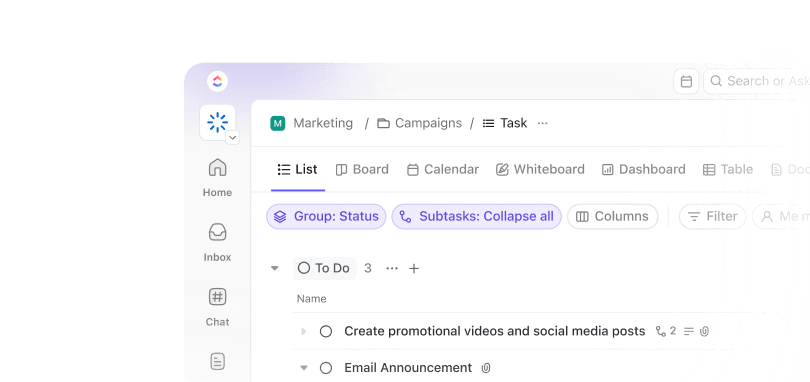Ancient Greeks had two words for time: Chronos and Kairos.
Chronos, the root of “chronology,” represents linear, sequential, and measurable time. Kairos, by contrast, means the opportune, qualitative moment—the right time to act.
While Chronos is easier to understand, Kairos feels more meaningful. It could be an aha moment, the right time to do something, or even a teachable moment. It isn’t just about timeliness (like a deadline) but also appropriateness (like a joke’s punchline).

Modern productivity discourse is obsessed with Chronos. We’re always talking about efficiency (doing things faster), even if the task itself is creative or the one doing it isn’t a machine. Our techniques and productivity hacks create systems that fail those of us who are differently wired. In the process, we overlook the inherently messy nature of work.
The growing popularity of the flowtime technique offers a gentler alternative.
- What Is the Flowtime Technique?
- The Problem with Rigid Timeboxing
- Flowtime vs. Pomodoro Technique
- Why Flowtime Matters for Productivity
- How to Practice Flowtime (Without Waiting for “Inspiration”)
- Benefits of the Flowtime Technique
- How to Implement the Flowtime Technique with ClickUp
- How AI Helps You Stay in Flow (Without Breaking It)
- Best Practices for Applying Flowtime
- Limitations of the Flowtime Technique
- Why Flowtime Is a Preview of the Next Era of Work
- The Unyielding Pleasure of Productivity
- Frequently Asked Questions
What Is the Flowtime Technique?
The flowtime technique is a time management approach that encourages you to achieve a state of ‘flow,’—complete immersion in a task for as long as your energy lasts, pausing naturally when focus fades.

The concept of flowtime draws from Psychologist Mihaly Csikszentmihalyi’s studies, trying to find answers to the question, “Why do people perform time-consuming, difficult, and often dangerous activities for which they receive no discernible extrinsic rewards?”
His team asked this question to several rock climbers, race-car drivers, chess players, athletes, and artists, all of whom described an experience that the researchers termed ‘flow.’
Flow in everyday life

Should I be a Grandmaster or an Oscar winner to achieve flow?, I found myself wondering. Thankfully, Csikszentmihalyi himself offers an answer.
He writes,
“It is what we feel when we read a well-crafted novel or play a good game of squash, or take part in a stimulating conversation.” Phew!
Being so engrossed in The Murder of Roger Ackroyd that I forgot lunch can’t possibly be the same as Karl Egloff climbing Kilimanjaro in under seven hours! Or is it?
Regardless of the task, being in flow is characterized by a handful of behaviors, sensations, and experiences. To begin with, flow merges action and awareness—you are so invested in the task at hand that you lose consciousness of your surroundings. Reading a book at an airport and missing flight announcements, for example.

By extension, it reduces self-reflection as well; you worry less and ignore what doesn’t matter. Someone staring at you for occupying two seats or spilling your coffee on your shirt stops bothering you.
With that out of your mind, you experience a greater sense of control, even if you feel that time itself is passing too quickly. Your mind is completely with the book, and you have the skill needed to enjoy it thoroughly, so there is no anxiety about losing control.
It also helps when you possess the skills to complete the task, set clear goals, and have mechanisms for regular feedback, even if not conscious.
Flow at work
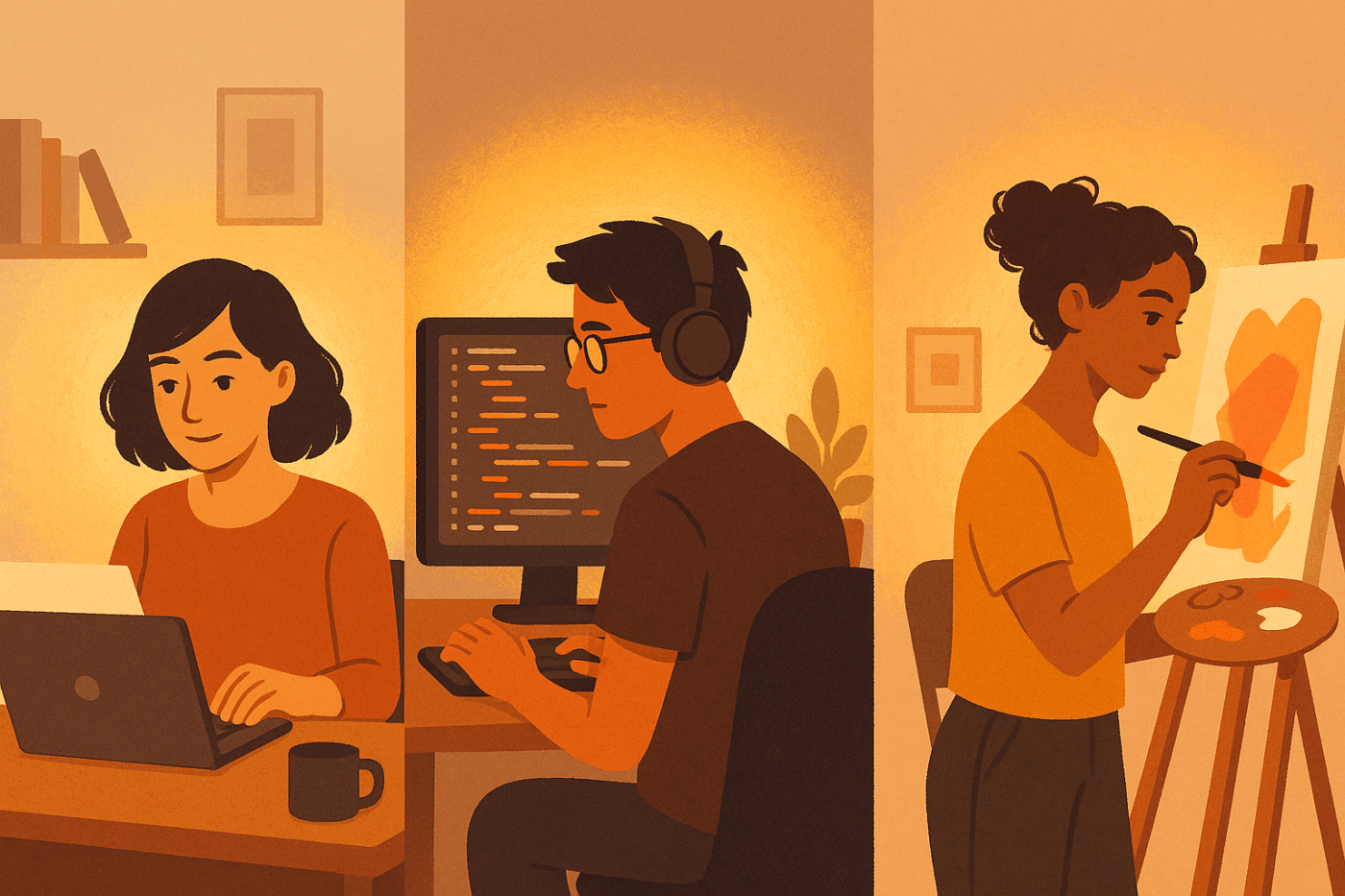
If the idea of flow feels like something that occurs to you, rather than a technique you can use, think again.
Japanese novelist Haruki Murakami starts by metaphorically cleaning off his desk:
🐣 Fun Fact: Serena Williams is known to practice for hours on end without a break. In 2021, the Hack Club chartered a train, The Hacker Zephyr, and hosted a hackathon that lasted 3,502 miles over 10 days.
Highly skilled people don’t just “find” flow. They engineer their environment to make it inevitable. Routine isn’t the enemy of creativity. It’s the doorway into it.
Developers, game designers, painters, singers, screenwriters—creative people across functions spend extended periods of time in a flow. They voluntarily immerse themselves in repeated practice to master their craft. This commitment fuels excellence and productivity.
Before we get into why flow time matters and how you can implement it for yourself, let’s understand how it’s different from other popular time management strategies.
The Problem with Rigid Timeboxing
Many modern productivity systems—Pomodoro, time-boxing, time-blocking, Eat That Frog, etc.—have one thing in common: Control.
They encourage users to take control of their time by assigning specific tasks to limited units of time. These methods recommend that you identify a task, schedule it for specific time slots, finish it, and take a break or move on to the next.
Time-boxing, a popular agile methodology technique, forces decisions to be made within a limited time period. But, wouldn’t a hurried decision only make matters worse? Well, it does.
📉 Research spotlight: Why timer-based systems backfire
Sergey Gelman of Concordia University, Canada, and Doron Kliger of the University of Haifa, Israel, ran an experiment to test the effect of time-induced stress on financial decision-making. They found that when investors experienced time-induced stress, like being stuck in traffic, they overweighted extreme-loss scenarios, impairing rational judgment.
Time blocking asks users to put in blocks of time for each task on a calendar. Schedule a task, get it done, this technique says. Except, there is significant research suggesting that putting ourselves under such time pressure can, in fact, be counter-productive.
This is true of perceived time pressure as well. Brandeis University researchers found that perceived time pressure can disrupt executive functioning. They show that increasing perceived time pressure “sped response times and worsened accuracy, cognitive inhibition (the Flanker effect), stress, and negative affect.” Decreasing perceived time pressure resulted in the opposite.
Flowtime vs. Pomodoro Technique
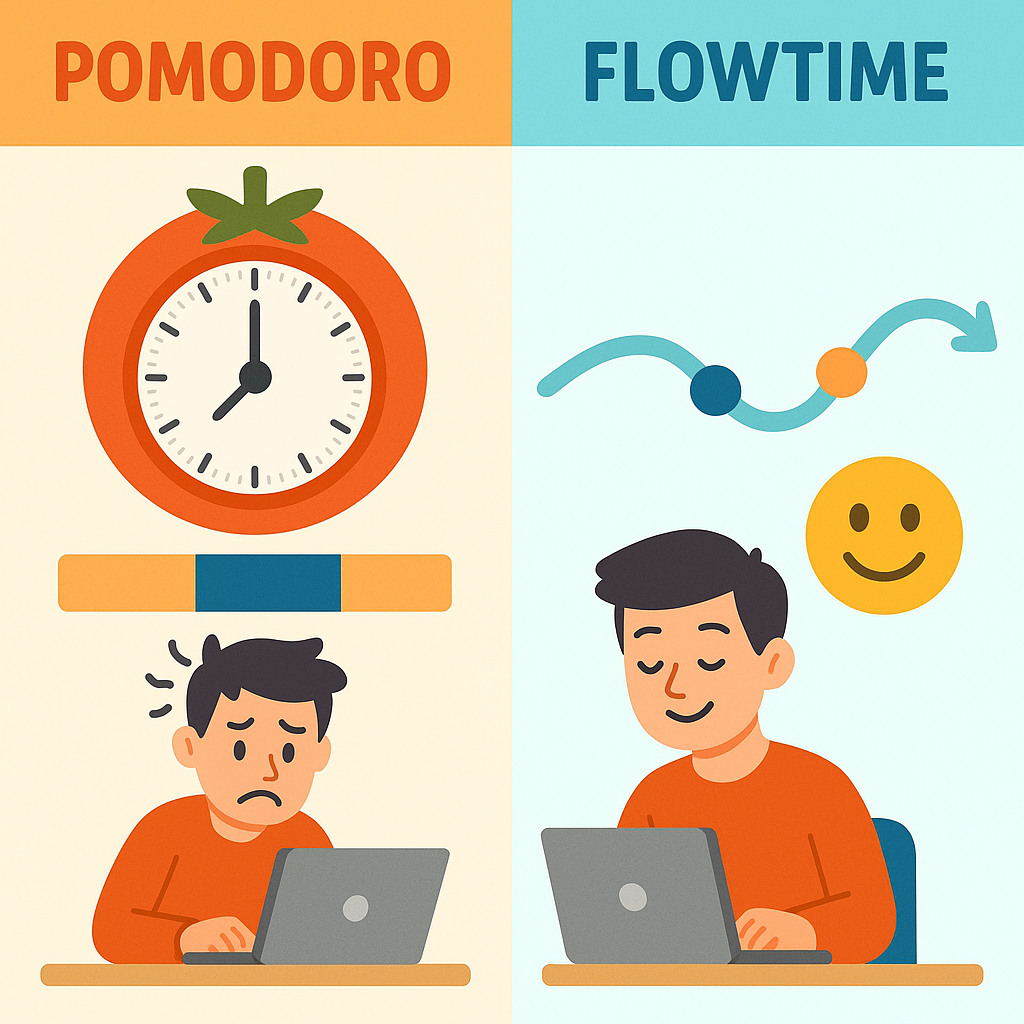
One of the most popular time management techniques, the Pomodoro, follows a similar approach. The Pomodoro method recommends a 5-minute break at the end of every 25-minute activity.
However, research shows that, when there is a forced time limit on something—a spurious urgency—the mere urgency effect comes to play.
“People will be more likely to perform an unimportant task over an important task that is clearly dominating in terms of payoffs, when the unimportant task is merely characterized by spurious urgency (e.g., an illusion of expiration).”
This means that you either hurry to a shallow job or choose the kind of work you believe you can get done in the time, irrespective of its importance.
💬 Quick Check: If a timer pulls you out just when you’re getting into the zone, Pomodoro is working against you—not for you.
The goal of the Pomodoro technique is to reduce internal and external interruptions. If you’re interrupted in the middle of a Pomodoro session, you either record-and-schedule the interruption or abandon the Pomodoro entirely. To account for unavoidable distractions, the Pomodoro technique schedules a mandatory 5-min break.
Most creative people are likely to just enter the zone in 25 minutes, forcefully ripping themselves out of the flow for a break. Getting back into flow at the end of the break is another steep climb altogether!
Here’s how flowtime becomes a great Pomodoro technique alternative.
| Pomodoro | Flowtime |
| Rigid sessions of 25 mins each | Flexible sessions built around the user’s energies |
| Scheduled breaks at the end of each session | Organic breaks at the end of the user’s natural flow |
| Countdown timer drives work, inducing timer anxiety and ineffective output | User’s flow state drives work, while timer just records patterns |
| Forced breaks disrupt concentration, constantly interrupting deep work | Encourages getting immersed in the task and taking the time you need |
| Requires clear structure and breakdown of task at hand | Adapts to unstructured or creative problem-solving tasks |
Why Flowtime Matters for Productivity

👀 Did You Know? In a study published in the Harvard Business Review, researchers found that for a single supply chain transaction, employees switched “350 times between 22 different applications and unique websites.” Throughout the day, they’d be toggling 3600 times.
Turns out, people spend nearly four hours a week just reorienting themselves after a toggle—9% of their annual work time. Qatalog’s research, conducted in collaboration with Cornell University, found that context switching makes teams less productive.
The flowtime technique prevents exactly this. It empowers people to put away the emails, Slack messages, notifications, social media, and other distractions to stay focused on one thing at a time.
It aligns with the natural flow of one’s thoughts and efforts to let them produce their best work. It allows creative people to close out the world and focus on the problem until they are ready to stop. It provides the freedom to go deep into the problem, take off on tangents, explore various solutions, test, learn, improve, and handcarve solutions.
The flowtime technique is almost entirely self-driven. During your flowtime, you choose to ease into the task, care for every step of the way, be entirely engrossed, and end/take a break only when it’s natural to you. Without the pressure of an external force, you’re less likely to be burned out, irrespective of the hours you put in.
Especially in startups and fast-paced organizations, it helps teams collaborate without losing their ownership of thought and work.
📖 Read more: How to recover from burnout!
How to Practice Flowtime (Without Waiting for “Inspiration”)
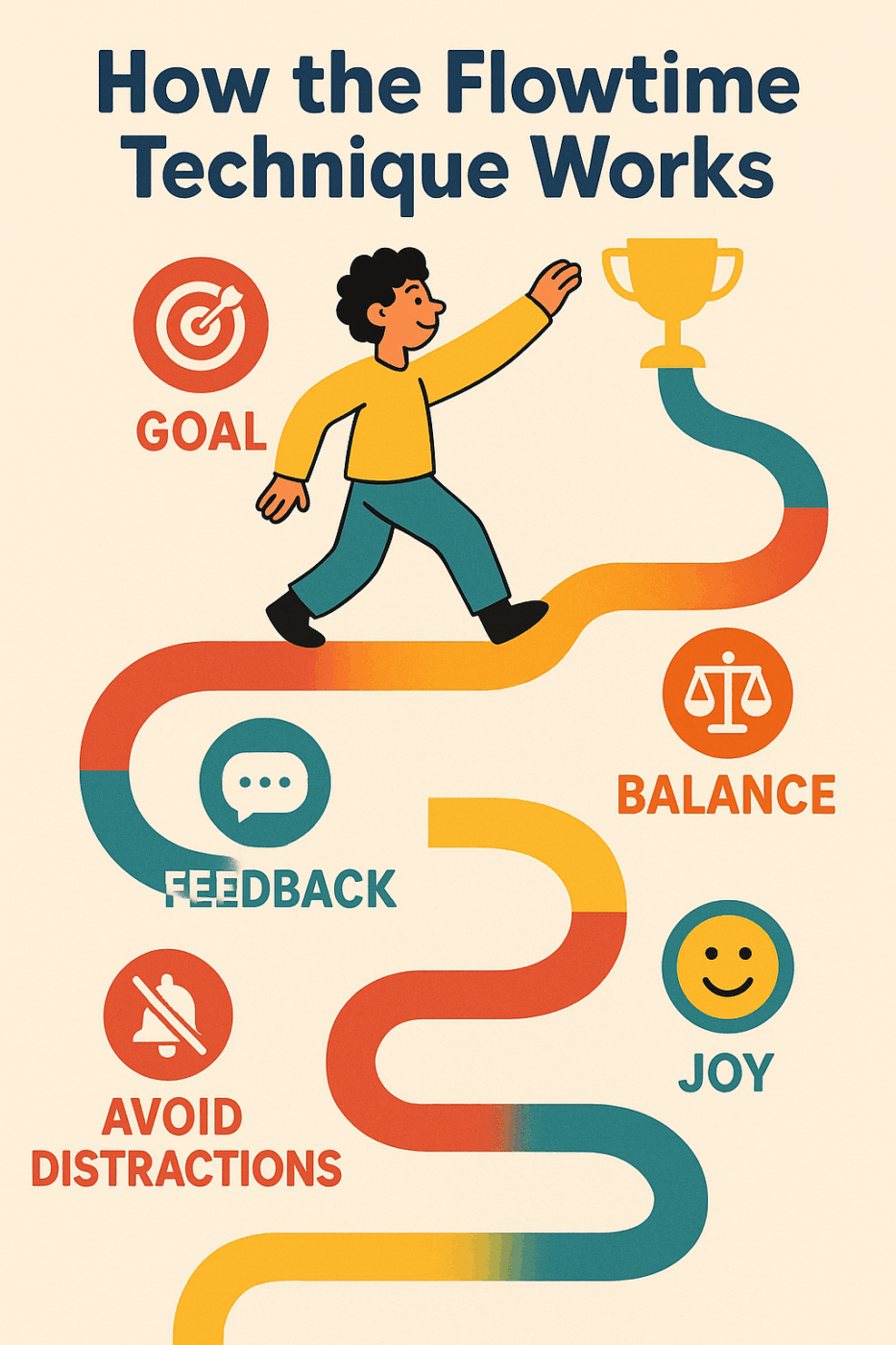
I began writing this article by time-blocking three hours on Monday. I sat at my desk, staring at an empty Google Doc for 30 minutes, before I gave up and doomscrolled in despair.
That same evening, after a refreshing nap, I was trudging on my treadmill, thinking about this article. The memory of learning about Chronos and Kairos from a podcast came back to me. I thought about all the times I’ve failed with the Pomodoro technique. I saw in my mind’s eye my calendar that was full of beautifully organized blocks that never went from wish to real world.
💬 Quick Check: Flow doesn’t arrive on command—but it does respond to conditions you can control: clarity, challenge, focus, and friction-free entry.
Nurturing that thought, I was pouring myself a protein shake, researching Mihaly Csikszentmihalyi and Jeanne Nakamura’s works, and learning about the origins of positive psychology. By the time the protein shake was drunk, I was at my desk, in a flow.
In many ways, this is how the flowtime technique works. However, if you’re thinking that flowtime is about waiting for inspiration or working only when an idea strikes you, you’re mistaken.
Flowtime is a flexible technique that takes advantage of your natural rhythms to help you do your best work. Psychologist Mihaly Csikszentmihalyi identifies specific conditions for flow in creativity, in his book about the subject, some of which are also great steps to follow if you’re looking to get in the zone.
1. Clarify your goals
A successful flowtime technique begins with a clear understanding of what you set out to achieve—what problem you need to solve, what article to write, what feature to build, which mountain to climb, and so on. Knowing your goal streamlines ideas and helps you spend your flowtime focused.
2. Set up feedback loops
While it is essential for creative individuals to receive feedback from users, readers, managers, and others, Flowtime requires a distinct approach. While using the flowtime technique, you need to have a system of evaluating your own work, measuring success, and iterating accordingly.
A developer might test the feature to see if it works in all environments. A designer might check for alignment, contrast, or information hierarchy after adding each element. A public speaker might record their talk and hear it back.
As a writer, my internalized feedback system tells me that the first paragraph in this section is incomplete without examples of simple internal feedback. So I added a few.
This kind of internal feedback is critical to keeping the flow going, like a personal cheerleader, if you will.
3. Balance your skills to the challenges
There is no flow state if the task is too easy. For instance, you might be doing dishes while watching a video or listening to a podcast—dishes only need a steady flow of water, eh? On the other hand, Rome wasn’t built in a day, flow or otherwise.
To use the flowtime technique correctly, your skills should match your challenges. Your goals should be achievable, yet challenging.

4. Avoid distractions
Marcel Proust spent his final years writing À la recherche du temps perdu (In Search of Lost Time), locking himself up in a dimly-lit, cork-lined room. While you don’t need to go that far, avoiding distractions is quintessential to achieving flow state.

Distractions interrupt flow. They make it harder to get back to the task at hand. They also stop you from losing yourself to the task and reaching a state where you forget self-reflection and consciousness of your surroundings.
5. Seek joy in doing the task (not the reward of completing it)
To be in flow, you need to feel the joy of working above any reward you gain from it. This means that you must enjoy the task for its own sake. Although the goal of this article is for you, dear reader, to enjoy it, I must find pleasure in writing it to get into the flow.
Like psychologist Donald Campbell says, “Don’t go into science if you are interested in money. Don’t go into science if you will not enjoy it, even if you do not become famous.”
I hope you don’t take this as me recommending you follow your passion or do what excites you. “Cricket is a game played by 11 fools and watched by 11000 fools,” George Bernard Shaw allegedly said. One person’s passion is another’s fool’s errand.
Despite that, you can use the flowtime technique to balance accounts, file bills, or even sort potatoes. There is intrinsic enjoyment in all of these activities as long as they interest you.
Benefits of the Flowtime Technique
A 10-year longitudinal study at McKinsey showed people in flow states were 500% more productive.
This doesn’t seem so hard to believe, given how flowtime works—in line with your natural productivity rhythms.
Flexible flowtime sessions support deep work. Forgetting space, time, and surroundings, you can focus all your energy on the one task in front of you. For those of us living with ADHD, flowtime means capitalizing on intense waves of concentration to stay productive.
Flowtime eliminates artificial time pressures. Without the rush of a deadline, you have the freedom to experiment, fail, and try again until you are satisfied with your work. By passively tracking time, instead of working against a timer, flowtime combats time-blindness, a common ADHD symptom.
Maintaining a routine can be hard. Especially while living with ADHD, routines can feel like another burden to carry. By integrating the flowtime technique into your life, you can ease that burden significantly. Here’s some help on how to make routines with ADHD.
👀 Did You Know? Many neurodivergent individuals report that the flowtime technique feels more aligned with how they focus—opting out of rigid timers and into longer, self-paced sessions.
As a corollary, flowtime also eliminates forced breaks, giving you the power to take breaks when they’re right for you. It’s great for creative, unstructured tasks. Instead of forcing yourself to do four slides in 25 minutes, you can spend eight hours making your best eight-slide presentation.
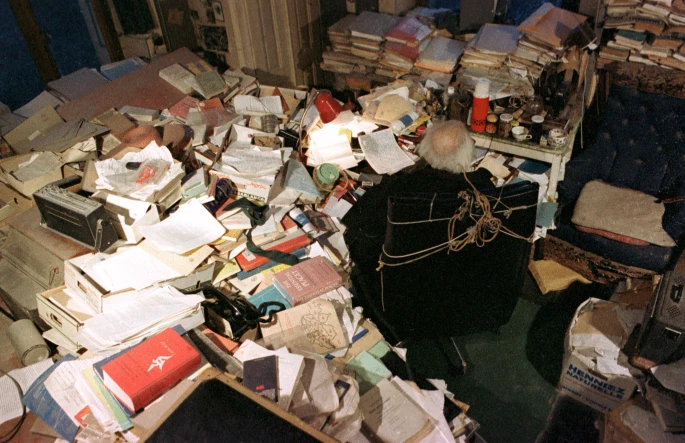
Most importantly, and personally, flowtime is a great self-awareness tool. It helps you know yourself better. While using flowtime, you can identify your productivity patterns, see how inspiration strikes you, and learn what you need to do better.
Whether you’re like Swiss psychologist Jean Piaget, who preferred a messy desk or Barack Obama, choosing to work well into the night, flowtime is a great way to sharpen your sense of self. Instead of forcing your ADHD mind to fit into rigid systems, flowtime gives you the safe space to understand your daily habits and adapt your productivity accordingly.
📮 ClickUp Insight: 60% of workers respond to instant messages within 10 minutes, but each interruption costs up to 23 minutes of focus time, creating a productivity paradox. By centralizing all your conversations, tasks, and chat threads within your workspace, ClickUp allows you to ditch the platform hopping and get those quick answers you need. No context is ever lost!
How to Implement the Flowtime Technique with ClickUp

Most people try Flowtime with a notebook and a timer app. It works—until you need to compare sessions, spot patterns, or notice that every Thursday you crash at 2 p.m. That’s where a system helps.
ClickUp acts less like a stopwatch and more like a focus observatory—a place where your deep-work sessions, breaks, energy dips, and task outcomes coexist instead of being scattered in separate notes.
💬 Quick Check: ClickUp doesn’t force timers—it tracks reality, so your patterns become data instead of guesswork.
Here’s what a Flowtime-friendly workflow looks like inside ClickUp:
1. Begin by observing, not timing
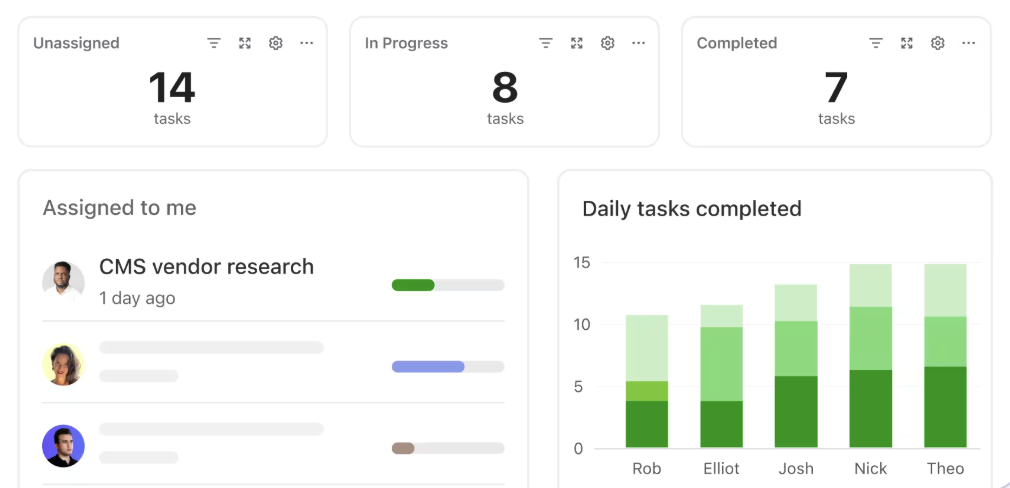
Instead of scheduling work in 25-minute blocks, create ClickUp Tasks for the actual chunks of work you want to immerse in (e.g., Write section 2, Prototype interactions, Analyze survey responses).
This removes the pressure of when to do it and shifts focus to what deserves full attention.
2. Find the patterns beneath your focus
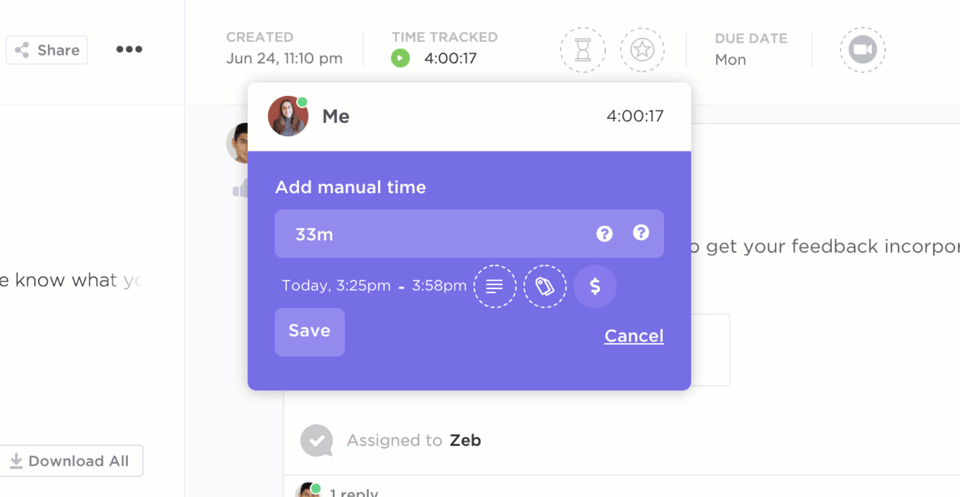
ClickUp Time Tracking and ClickUp Dashboards turn these observations into insight. Instead of cold numbers, you see rhythms: average session lengths, focus streaks, natural break cycles. It’s data with empathy—more reflection than report. You begin to notice things you didn’t before: the way your energy peaks after lunch or how your best ideas happen late at night.

Over a week or a month, those sessions become a dataset you can learn from:
When do I enter the flow fastest? How long can I sustain deep work before I need a break? Does writing drain me more than design work?
4. Let the system care for you
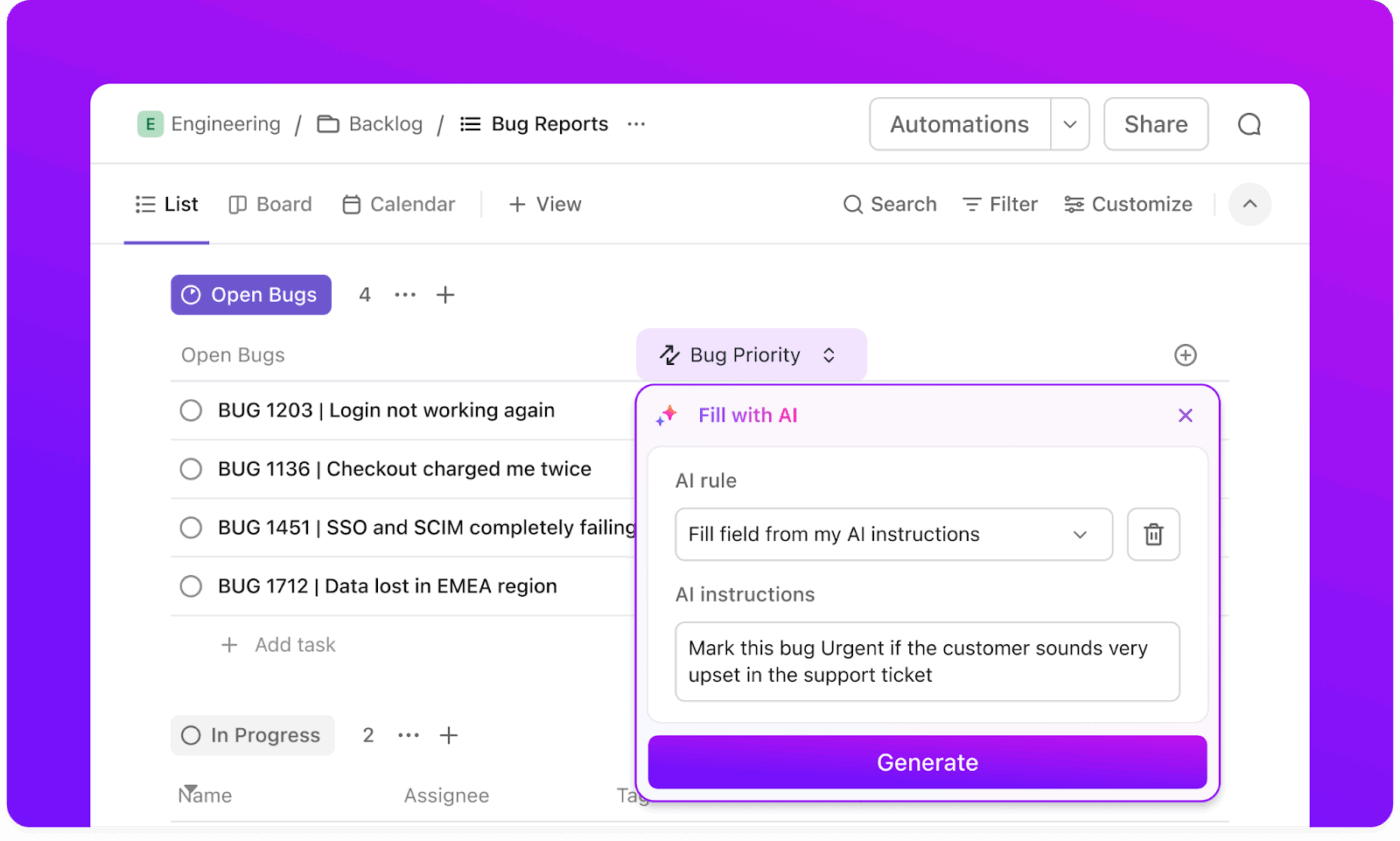
Flowtime’s biggest risk is overdoing it—focus turning obsessive before you realize your shoulders have locked up and your coffee’s gone cold. That’s where ClickUp Automations step in. They can nudge you to pause after a long session, remind you to hydrate, or quietly surface a question: Still in flow, or just refusing to stop?
This keeps flowtime from becoming Flow-until-migraine.
5. Record what flow feels like
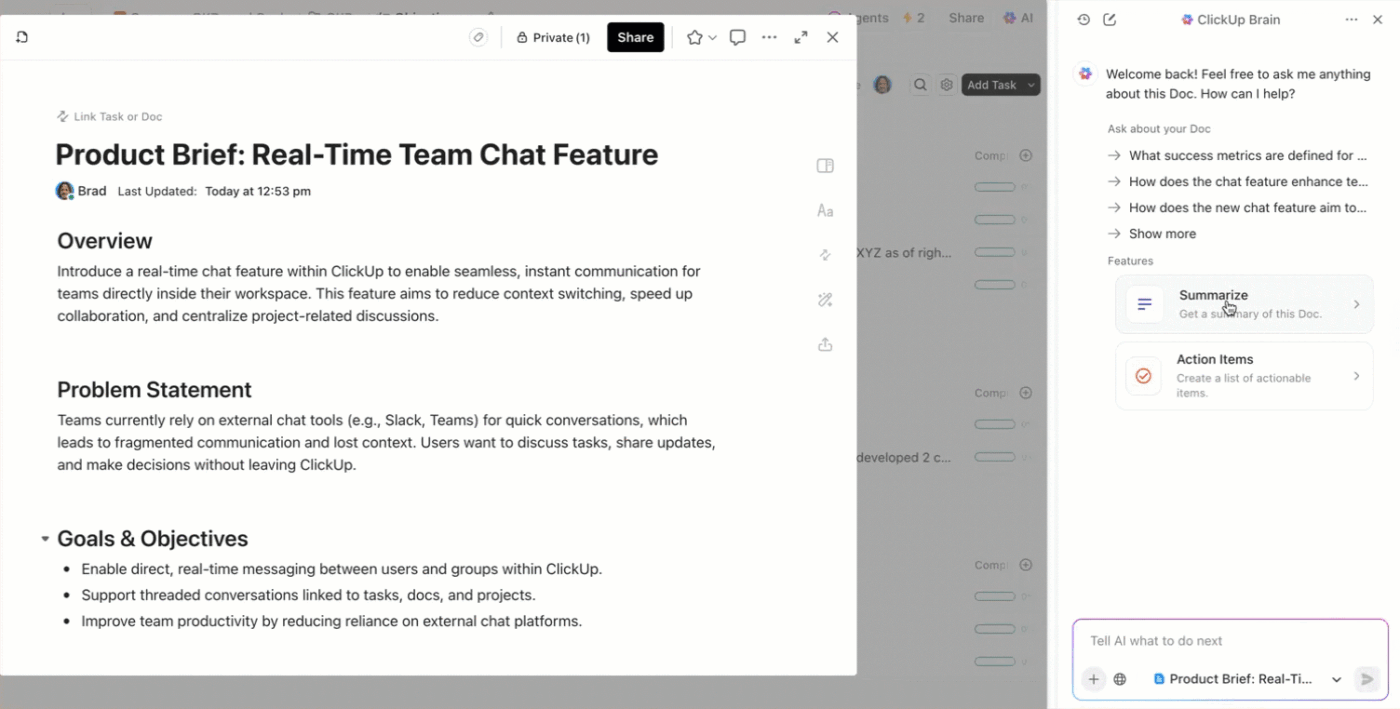
For the more introspective, ClickUp Docs offer a space to jot quick reflections after each session. What clicked today? What broke your focus? Over weeks, those small notes become a living archive of your creative rhythm—your own user manual for attention.
✅ Bonus internal fit:
ClickUp Docs + Time Tracking + Dashboards = a living, evolving productivity profile—not guesswork.
Why ClickUp Works for Flowtime
Flowtime respects attention as something organic—cyclical, fragile, and deeply personal. ClickUp gives that attention structure without suffocation.
Its tools are not built to squeeze efficiency out of you, but to create an environment where your best work can surface. The timers don’t command; they observe. Dashboards don’t measure; they reveal. Automations don’t interrupt; they protect the body doing the work.
Used right, ClickUp doesn’t feel like software at all. It feels like a second, calmer brain—one that remembers what your first forgets: when you’re most alive in your work, when to stop, and when to begin again. Flowtime thrives in that kind of ecosystem, where guilt is replaced by visibility and awareness takes the place of pressure.
How AI Helps You Stay in Flow (Without Breaking It)

The biggest risk with Flowtime is context switching.
The moment you tab out to “quickly draft an email” or “look up that source,” you’re not in flow anymore—you’re in fragmentation.
ClickUp Brain prevents that by letting you stay inside the work while still getting what you need.
Keep thinking where you’re working
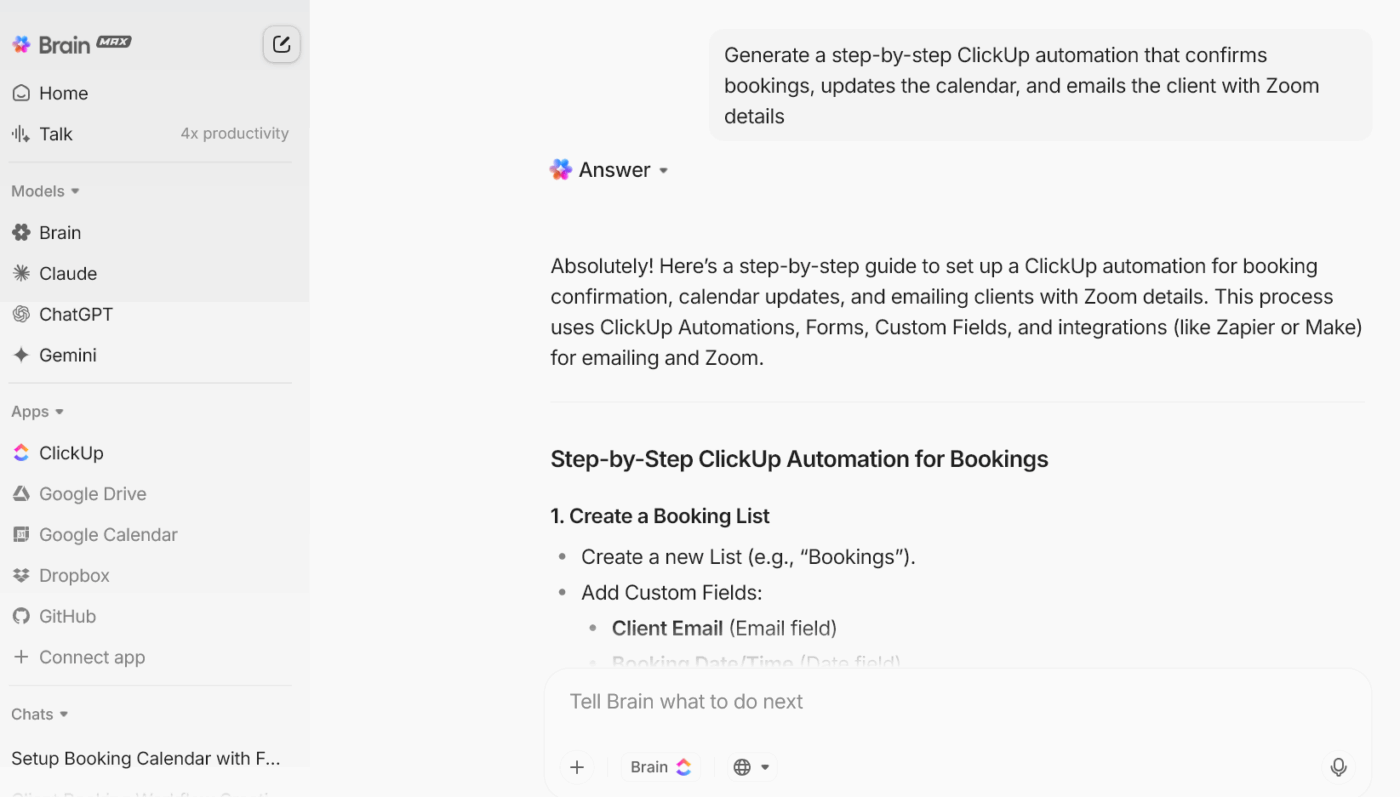
When your thoughts start moving faster than your fingers, ClickUp Brain MAX lets you speak instead of type. You can dictate ideas, next steps, or fleeting insights right inside your task. Talking keeps pace with thinking, allowing momentum to carry on uninterrupted.
Let AI write with you, not for you
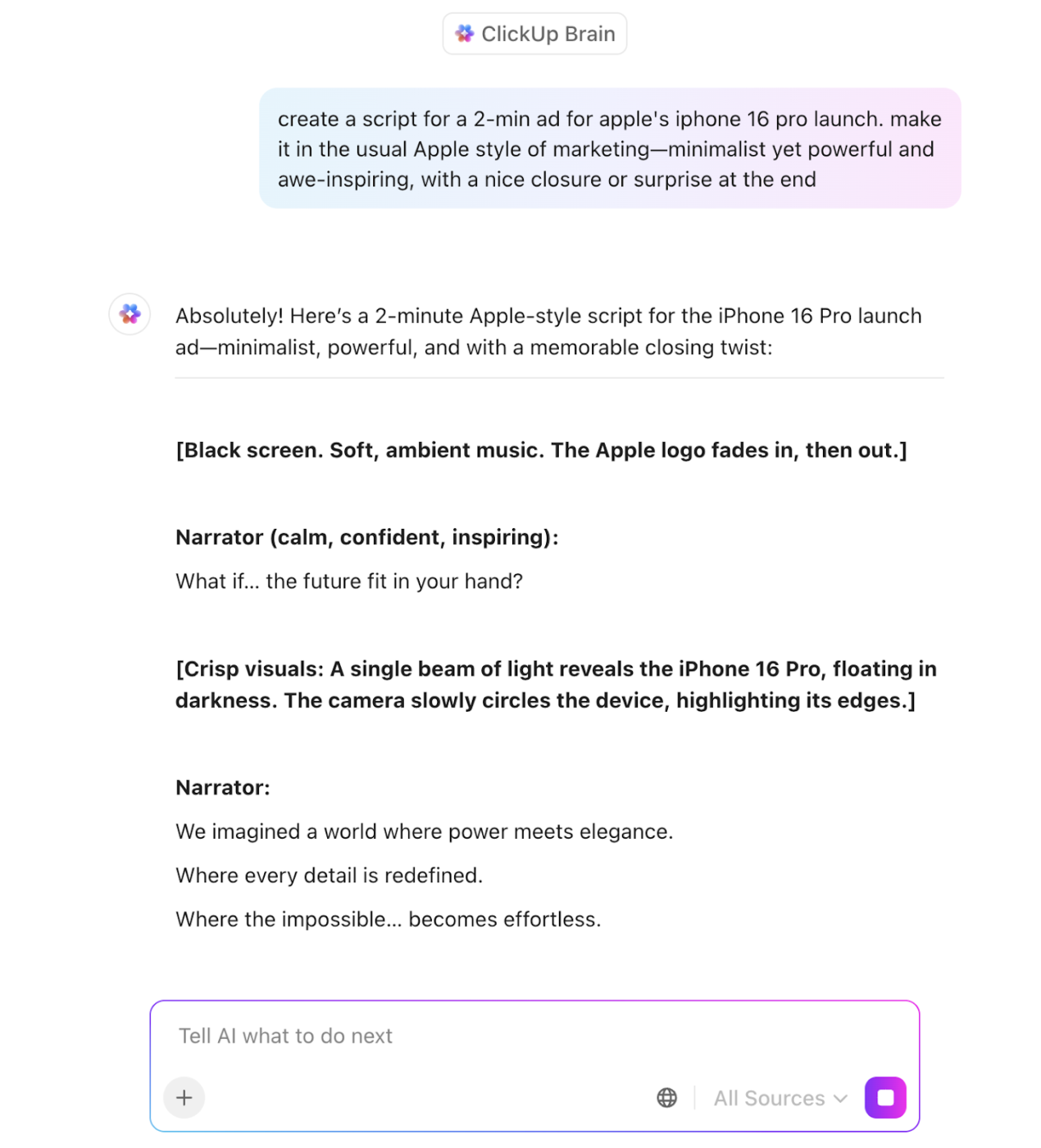
If those thoughts need shaping, ClickUp Brain as an AI writer helps you do it without leaving your flow. It can clean up phrasing, reframe tone, or turn a scattered list into a draft—all inside ClickUp. No switching apps, no breaking stride.
See what your mind’s been trying to tell you

Meanwhile, AI Insights quietly studies your tracked sessions. It surfaces patterns—when you’re most focused, which tasks drain your energy faster, and when you tend to skip breaks. It’s not judgment; it’s a map of your attention over time.
Why AI + Flowtime Works
Flowtime ≠ “just work when you feel like it.”
It’s “work with intention, protect the zone, and learn from the data.”
AI handles the friction points—switching apps, typing everything manually, re-formatting, searching for notes—so your cognitive load stays on the thing that matters, not the admin around it.
Overwhelmed by too many “urgent” tasks and not enough real progress?
This video breaks down simple prioritization strategies you can start using today so you stop firefighting and start moving the work that actually matters.
Best Practices for Applying Flowtime
In a way, he implies that you can control what you’re paying attention to and perhaps ease yourself into a state of flow.
Doing that isn’t a trick, but a conscious practice consisting of various steps. To begin with, using flowtime well demands that you track your activity consistently. While you don’t need to schedule tasks or start/stop at a particular time, a detailed log of your work time can be very useful in identifying your patterns of flow.
Once you have these logs, review them regularly. A week is a good amount of time to see recurring patterns. You might notice that it’s easier for you to get into flow early in the morning, when there’s absolute silence, or late into the night, when you feel completely alone. Identify these hours so you can optimize your work hours in tandem. A tool like ClickUp Brain can help with these insights, too.
💡Pro tip: Customize your AI tools to suit your unique needs. Beyond just creating content or summarizing text, use AI to understand yourself better and take meaningful action. Here is a primer on how to use AI for productivity.
While reviewing, also consider which of your tasks truly require a flow state. For instance, filling your timesheet or filing your reimbursements might not need all your attention. Even core aspects of your job can fall in this category. I, for one, don’t need to be in flow to optimize my writing for SEO or run it through Grammarly. Know what needs flow and organize your work hours around that.
Most importantly, remember that the flowtime technique doesn’t force you to take breaks. So, it is entirely on you to take them as and when you need. I turn on the ‘announce time’ feature on my computer to keep me conscious of the time—need to feed the cats too, by the way. You can just keep the window open to know when the sun sets.
Alongside that, pay attention to your body with a minute break. Notice shallow breathing, any aches, hunger, thirst, etc. These might feel like unnecessary distractions, but they are the alert messages from your body to ensure you don’t drain yourself out in your flowtime.
The future of productivity is shifting from “clock visibility” to “output visibility.” Flowtime fits the world async work is becoming.
Limitations of the Flowtime Technique
Rooted in scientific research and geared toward high performance, the flowtime technique is a great productivity tool.
Conditions apply.
Flowtime is for the self-initiators. It requires that you possess the self-discipline and activation energy needed to start the task and get into flow. It also demands that you feel satisfaction and contentment in performing the task itself—and not the reward.
Unfortunately, these conditions may not occur all the time or for all the tasks. Sometimes, you need the timer-induced anxiety to finish tasks you don’t particularly enjoy—like writing up reports or sorting through documents. In a way, flowtime is best for the discerning.
Moreover, flowtime also needs the discipline to log your work accurately and honestly. If you forget to turn on your time tracker and make approximations later, you’ll lose the insights you need to optimize flowtime.
At the other end of the spectrum, if you’re working on something you love and are always in flow, you might skip breaks and risk cognitive fatigue. Researchers define cognitive fatigue “as an executive failure to maintain and optimize performance over acute but sustained cognitive effort.”
When you’re in flow, activating grey cells over an extended period of time, you’re more likely to hit cognitive fatigue. Over the long term, this can mean burnout. To make the best use of flowtime, it is important to prioritize downtime too.
Then, there is the matter of distributed teams and collaborative work. Especially if you’re part of a workflow that requires you to collaborate with team members, you would have to show up at a specified place and time, irrespective of being in flow. In such cases, flowtime might be more disturbing than empowering.
Why Flowtime Is a Preview of the Next Era of Work
This decade has seen extraordinary disruption in the work landscape.
👀 Did You Know? The World Economic Forum identifies that 39% of today’s skills will be transformed or become outdated by 2030. Businesses are evolving to support employee health and well-being, a dimension identified to be the top focus for talent attraction.
Flexible work hours and productivity models are crucial aspects of that. Successful new-age organizations like Atlassian are committing to a fully distributed model of work. Dropbox is virtual-first. As more and more organizations are digitized, we expect this to be the primary way people work in the future.
Fully-remote, virtual-first, distributed teams also tend to be high-trust environments where team members have the power to plan their work their way, incorporating their needs to take breaks, while making space for collaboration. Flowtime is a preview of what that would be like.
Imagine a creative team across product development, content, customer experience, marketing, and advertising working together to define goals and requirements, then breaking away to do deep work on their own.
This model already exists, but the constant pressure to collaborate often overrides individual autonomy and cuts into focused creative time. The result is alert fatigue, context switching, and a slow erosion of cognitive space.
70% of meetings serve more to interrupt and add to employee overload rather than help them. All of this also adds to the psychological price of meetings.
Organizations are slowly learning this impact and encouraging more self-managed teams.
Generative AI tools are helping with this transformation, allowing employees to access unstructured data across sources without disturbing another individual.
👀 Did You Know? BCG recommends that “a GenAI strategy should aim to make work more enjoyable,” aligning perfectly with the principles of flowtime. Several organizations are starting on this journey, enabling every employee to use AI as their own personal assistant.
As the nature of work evolves, challenges we face become complex, more ‘regular work’ gets automated, and the tools we can access expand, the most valuable asset is bound to be human ingenuity. In other words, getting into a flow.
The Unyielding Pleasure of Productivity
Doing great work—by one’s own standards—is the ultimate source of contentment.
Taking pleasure and pride in one’s work is fundamental to the desire to do it over and over. In plain terms, no one does a good job of a job they hate.
Yet, most productivity frameworks today focus on brute-force methods to make someone work. Take the Pomodoro, for instance. Its fundamental approach is to force someone to sit down and do the work for 25 minutes, no exceptions. More often than not, it doesn’t work that way.
As a professional writer, I don’t have the luxury of waiting for inspiration. Neither can I get my creative juices flowing at the chime of a clock. What I seek is a balance. A system that understands my need to ease into a zone, while holding me accountable for finishing the work assigned to me.
The flowtime technique is exactly the balance I need. It pushes me to clarify my goals, avoid distractions, and seek feedback, without cutting me off. It helps me tune my flow based on my own unique patterns and behaviors. It makes me aspire to be creative without creating anxiety around it.
The Chronos take a back seat, while I enjoy the Kairos of writing words I’m proud of. In my book, that’s a win!
Frequently Asked Questions
What is the Flowtime Technique, and how is it different from Pomodoro?
The flowtime technique is a flexible approach to managing your time. It encourages you to achieve a state of ‘flow,’ where you’re completely focused on a task for as long as you are energized by it, and stop naturally when you lose your focus.
Unlike the Pomodoro, it doesn’t restrict the time you work or the breaks you take. It is flexible and customizable.
Who benefits most from the Flowtime Technique?
The flowtime technique is perfect for creative people who ease into their work and need longer hours to complete their tasks. It is also great for those with anxiety issues or ADHD, as it is gentler on rigid deadlines.
How do you track Flowtime sessions digitally?
The best way is to use an app with a start/stop button that you can toggle based on your sessions. ClickUp Time Tracking allows you to do this effortlessly across devices.
Can flowtime improve focus and deep work?
Flowtime is designed specifically to improve focus and enable deep work. It allows you to get into the zone, approaching a problem from various dimensions, and create comprehensive solutions. It also helps you complete tasks in shorter durations because you’re giving it undistracted attention.
Is flowtime suitable for teams or mainly individuals?
Flowtime is built on the foundations of individual experience, which can vary widely among team members. When one of them gets in a flow and another doesn’t, it can become a distraction, counterproductive to flowtime. So, it’s mainly for individuals.
However, teams working towards common goals can use flowtime to guide their collaboration sessions. For instance, you can brainstorm together using flowtime to set goals, eliminate distractions, and explore deeper ideas.

